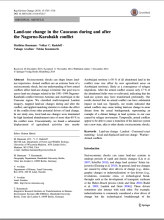/ library resources
Showing items 1 through 9 of 11.Socioeconomic shocks can shape future land-use trajectories. Armed conflicts are an extreme form of a socioeconomic shock, but our understanding of how armed conflicts affect land-use change is limited.
The agricultural sector in Armenia contributes around 20 percent to gross domestic product and provides employment to around 40 percent of the country’s labour force. The backbone of agriculture in the country is represented by smallholders and family farms.
The Decree concerns compensation for the privitization or cutting down of vineyards and orchards. (3 articles)
"The maximum number of individual lots to be granted as property should be fixed on the extent of cultivable land of a given collective farm that is subject to distribution (irrigated arable land, arable land without irrigation, vineyards, orchards)." (one article)
The regulation contains the procedures and considerations for the allotment of land plots. The Regulation makes specifically provision for agricultural land. In the case of "condemnation" or temporary use of land for state or public needs land users or landowners are entitled to compensation.
The document contains classification list of the stock of land by categories and economic significance areas. The stock of land is subdivided into the following categories and areas of economic significance: 1. agricultural land; 2. urban land; 3. industrial land and non-agricultural land; 4.
Supreme Soviet, taking into consideration financial situation of refugees that have moved over for permanent residence to the territory of the Republic of Armenia, decrees to establish that the following privileges are established for those that have expressed the desire to organize peasant and c
Land Code defines the basic directions of State regulatory system improvement concerning land relations, development of various organizational and legal forms of land economy, fertility of land, improvement of land use efficiency, protection and improvement of the environment – favourable for hum
The former socialist countries of Eastern Europe (that is, Europe east of Germany and west of the Urals, but including all of Russia) began a transition to a market economy in the late 1980’s and early 1990’s.
Paginering
Land Library Search
Through our robust search engine, you can search for any item of the over 73,000 highly curated resources in the Land Library.
If you would like to find an overview of what is possible, feel free to peruse the Search Guide.



